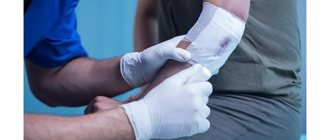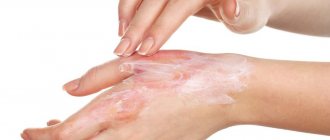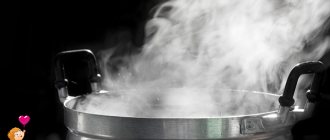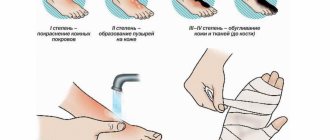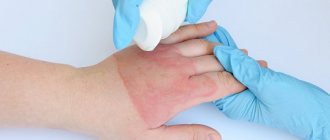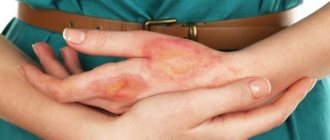Remedies for burns sold in pharmacies
Today, you can purchase anti-burn products of various types and forms in the pharmacy. They differ somewhat in their characteristics.
Aerosol
Aerosols are effective in providing first aid immediately after a burn. We are talking about grade 1 and 2 lesions if there are no open wounds on the surface of the skin. In this case, using an aerosol will help relieve pain symptoms; the product will do an excellent job of swelling and redness. And its convenient form allows you to apply it without touching the affected area of the skin: the spray or foam is sprayed remotely.
The principle of operation is very simple: the aerosol is shaken and sprayed from a 15-centimeter distance onto the burn, while the bottle must be held vertically.
There are light aerosols and aerosols with foaming components for grade 2 damage.
Burn gel
Gels for burns have a light texture and non-greasy composition; they are quickly absorbed, relieve primary symptoms after skin damage, and additionally soothe and moisturize. Unfortunately, gels are not suitable for treating deep skin burns - only mild and not extensive lesions of the 1st, or less often 2nd degree.
Unfortunately, gels are not suitable for the treatment of deep skin injuries - only mild and non-extensive lesions of 1st, less often 2nd degree.
Ointment for burns
Thicker and more viscous than gel. It is advisable to use ointments for 1st and 2nd degree burns and at all stages of healing of more serious burns. Doctors also recommend applying compresses to the damaged area of skin with anti-burn ointments - they often contain components that accelerate regeneration.
Burn cream
The composition of creams that may be indicated after burns includes special components:
- Reducing inflammation (for example, violet and string extracts),
- Having an antimicrobial and disinfecting effect (for example, walnut extract, iodine),
- Accelerating the process of skin cell regeneration (for example, vitamin B5).
Burn creams not only promote the healing of damaged skin, but also have a moisturizing and nourishing effect. One of the advantages of creams is that their use has a positive effect on the condition of the skin as a whole.
Anti-burn wipes and dressings
Refers to first aid equipment. Their surface is impregnated with a special composition that allows you to relieve the first painful symptoms.
The main advantage of these products is that the napkins are convenient to use in “field” conditions. You can always take them with you on a hike, and if someone accidentally gets burned at the fire, you can help the victim.
Anti-burn dressings are applied to the affected area while waiting for the ambulance to arrive.
Which ointment is suitable for burns with boiling water
For a burn with boiling water, the following are suitable for treatment: Levosin ointment, Spasatel balm, good results were obtained from Eplan cream. The latter remedy has a disinfecting and protective effect. The use of the cream helps to quickly relieve pain and inflammation after thermal and chemical damage. When applied, it forms a protective film, under which the skin is restored. The drug has no restrictions for use (except intolerance).
Cream Espan Ointment Levosil
The effect of application occurs instantly and lasts up to 4 hours. Before use, the burn surface is treated with an antiseptic solution. The cream is applied in a thick layer, can be repeated up to 5 times a day, the course continues until complete recovery.
Oil burn ointment
Stellanin ointment contains anti-inflammatory, analgesic and antimicrobial components that help with burns from boiling water and oil. The use of the drug allows you to quickly relieve swelling and speed up the healing of damaged skin. An important feature is the prevention of infection and scarring. The ointment is suitable for the treatment of thermal burns from 1 to 3 degrees. Apply a thin layer 1-2 times a day to the damaged area, covering 1 cm of surrounding skin.
Stellanin ointment
From chemicals
For chemical burns, drugs with a neutral composition are used, that is, when there is a proven absence of interaction between the active substance and the damaging factor. Solcoseryl, Methyluracil, Panthenol ointments are used.
High efficiency for such injury was noted for Emalan hydrogel. It contains the protein collagen, which:
- binds and retains water in the skin;
- stimulates the formation of its own collagen proteins necessary for healing;
- has the ability to carry drugs deep into tissues.
Emalan hydrogel
Emalan relieves pain and inflammation, destroys microbes, stimulates oxygen absorption, and accelerates restoration of the burn surface. This drug cleans the wound and prevents the development of infection. Used for all types of burns. Apply a thin layer (1-2 mm) to the skin, after 1-2 hours or after complete drying, repeat the application until the pain subsides
From thermal
For thermal burns (boiling water, hot metal, oil), Furacilin ointment is used. It helps relieve inflammation and prevent infection, speeds up healing. The ointment is especially effective for grade 2-3 lesions. Apply after treating the skin with an antiseptic 1-3 times a day.
Furacilin ointment
If the affected area is large, it is used with caution in children, nursing and pregnant women, since the risk of absorption of furatsilin into the blood must be taken into account.
For eyes
Korneregel is an eye gel containing dexpanthenol. It has an anti-inflammatory and protective effect, speeds up the healing process. It is instilled one drop in the acute stage every 2 hours, and as it improves, drops are dropped 3-5 times a day. When applying, it is important not to touch the conjunctiva with the tip of the tube.
Korneregel
Modern anti-burn drugs: a review of effective agents
There are a variety of anti-burn products on the market: sprays, gels, ointments and creams that have an anti-inflammatory, disinfecting, healing and soothing effect that promotes healing of the affected area. Some drugs are effective in themselves, while others need to be used as adjuncts.
Panthenol
Panthenol is an anti-burn drug, used to treat burns of varying severity, available in the form of a spray, gel, ointment, cream and aerosol.
The main active ingredient is dexpanthenol, which accelerates the regeneration of skin cells. Panthenol spray is used immediately after a sun or thermal burn - it has an anti-inflammatory effect. At the treatment stage, it is better to give preference to Panthenol ointment, gel or cream.
Olazol
Olazol is a remedy that is effective for thermal burns. Available in aerosol form. Due to the components included in the drug (chloramphenicol, anesthesin, sea buckthorn oil, anhydrous lanolin, etc.), Olazol has an analgesic, anti-inflammatory and antibacterial effect.
A very effective remedy for thermal damage of 1st and 2nd degree.
Furaplast
A drug for external use, which is intended for the treatment of burn wounds. Due to furatsilin, which is part of the drug, Furaplast has an antiseptic effect. The drug is applied to the burn site in an even thin layer to form a special protective film. The film lasts for several days; if it is damaged, Furaplast must be reapplied.
Important: Furaplast will not be able to help if inflammatory processes or suppuration have begun in the damaged area of the skin.
Another active ingredient, furatsilin, has an antiseptic effect.
Please note: it is not recommended to use Furaplast if inflammation and suppuration have begun at the burn site - the film will not allow the skin to breathe.
Solcoseryl
Solcoseryl ointment and gel is an effective remedy for burns of 1st, 2nd and even minor injuries of 3rd degree. The main active ingredient is cattle blood extract, while the drug is purified from protein. This composition helps to increase metabolism in skin cells, resulting in rapid healing.
The gel and ointment are applied directly to the surface after preliminary cleansing of the skin using a disinfectant solution.
Bepanten
Bepanten has an analgesic effect. Due to dexpanthenol, which is included in its composition, Bepanten is able to accelerate the healing process of wounds after burns. Bepanten can also be used as a first aid remedy for burns. The drug is commercially available in the form of ointment and cream. In addition, Bepanten is suitable as first aid for 1st and 2nd degree burns: the ointment has an analgesic effect.
La Cree
La-Cri cream for sensitive skin was created specifically to relieve skin irritations. Including those occurring after minor burns.
This remedy includes extracts of licorice, violet, string and bisabolol, which reduce inflammation. Walnut extract has an antimicrobial effect, while panthenol and avocado oil soften the skin and stimulate its regeneration.
Due to the absence of dyes and fragrances, La-Cri ointment can be used even by newborns. It will become a reliable assistant after burns in children and adults - see for yourself!
Olazol
“Olazol” is a multi-component spray for burns with a whole complex of active substances: cell regeneration stimulator (sea buckthorn oil), pain reliever (anesthesin), antibiotic (chloramphenicol). “Olazol”, thanks to this composition, is suitable for the treatment of complex burns and wounds: infected burns and non-healing wounds, trophic ulcers, microbial eczema and other wounds with bacterial infections. The advantage of the drug is that it contains an anesthetic for local anesthesia - this allows you not to take such drugs orally.
Among the disadvantages of this remedy for burns are individual intolerance and unwanted reactions when used after sunburn. The fact is that Olazol contains an antibiotic that can cause allergies.
Olazol
AltaiVitamins, Russia
Olazol is a remedy for the treatment of wounds and ulcerative lesions.
The combined drug has an anesthetic, antibacterial (shows activity against many gram-positive and gram-negative bacteria, pus-causing microbes, Haemophilus influenzae bacteria, Brucella, rickettsia, chlamydia, spirochetes) and anti-inflammatory effect, reduces exudation, promotes tissue regeneration and accelerates the process of epithelization of wounds. Used for burns. from 175
5.0 1 review
618
- Like
- Write a review
Auxiliary products for burns
Rescuer
Suitable as an additional product. This domestically produced ointment is known for its natural composition and universal healing properties. Most likely, you will find a Rescuer in your first aid kit - use it when treating burns for their quick healing.
Actovegin
It is an ointment that effectively copes with sunburn. In some cases, it can be used to prevent burns after radiation therapy sessions.
Chlorhexidine solution
Suitable for disinfecting burn surfaces. You can apply a bandage soaked in Chlorexidine to the affected area or irrigate the burn several times a day with a 0.5% solution.
Alternative burn remedies for home treatment
Anti-burn products for home treatment can also be used in the form of spray, cream, powders, films. If necessary, take painkillers, antibiotics, and antiseptics.
Spray
The spray is convenient for application, since it does not require contact with the burn surface and it is easy to distribute the drug over a large surface. The most well-known drugs are Panthenol and Olazol spray.
Spray Panthenol Spray Olazol
Creams
Creams (Bepanten, Eplan) differ from ointments in that they have a more watery and absorbent base. They are suitable for children's skin, application to the face, skin folds and other sensitive areas of the skin.
Powder
The antibacterial drug Baneocin or powdered Streptocide is used as a powder for the burn surface. After cleansing with antiseptics, burns are treated with them at the risk of suppuration.
Baneocin powder Streptocide powder
Film
Burn films help maintain optimal water balance, which ensures normal conditions for healing. They consist of hydrogel and do not stick to the wound. They can be impregnated with analgesic and antiseptic components.
Painkillers
Anti-inflammatory drugs for burns are used in the first two days, as they help reduce redness, reduce temperature, and painkillers dull the pain of the skin. The most effective remedies are Paracetamol, Aspirin and Ibuprofen. Take one tablet 1-3 times a day. Long-term use is not recommended.
Antibiotics
Antibiotics for burns are prescribed when there is a threat of infection or suppuration of the burn surface has already developed. Such a complicated course is usually a reason for inpatient treatment. Drugs are administered taking into account the sensitivity of infectious agents.
The following groups of drugs are most often prescribed:
- aminoglycosides – Gentamicin, Amikacin;
- penicillins with clavulanic acid - Amoxiclav, Augmentin;
- fluoroquinolones – Cifran, Tsiprinol;
- cephalosporins – Ceftriaxone, Cefazolin.
Gentamicin Amoxiclav Cifran Ceftriaxone
Antiseptics
Antiseptics in solutions are needed to treat skin in case of burns; they are used before applying ointments in the form of irrigation. This helps cleanse the skin, disinfect the burn surface and speed up recovery.
The most commonly used aqueous solutions are:
- Chlorhexidine,
- Miramistin,
- Octenisept,
- Furacillin,
- Dioxidine.
Chlorhexidine Miramistin Octenisept Furacillin
Home remedy for burns
If you don’t have an anti-burn medication on hand, then home remedies for burns can come to the rescue.
The speed of first aid plays an important role in how serious the consequences will be. The best remedy for skin burns is to interrupt contact with the hot surface as soon as possible and cool the damaged area of the skin.
Cooling the skin with water for a burn
If there are no open wounds, keep the affected area under cold water for at least 10 minutes. Cold will not only help reduce painful symptoms, but will also prevent the burn from spreading further. In case of chemical burns, it is also necessary to quickly wash off or neutralize the substance.
If there are no suitable medications in your home medicine cabinet, turn to proven “grandmother’s” methods.
Folk remedies for burns
- Toothpaste containing menthol can be applied to the site of a minor burn.
It will help relieve pain, protect against germs, and relieve swelling. And if you leave it on the skin in a thin layer, the paste will not allow moisture to evaporate from the skin tissue, which means the surface of the skin will not dry out. A small burn can even be cured with a few applications of toothpaste. - If you have an aloe flower growing at home, you can use its leaves to treat a burn.
To do this, you will need to thoroughly wash and cut one sheet lengthwise and bandage it to the damaged skin. Or you can make a paste from the leaf and even squeeze out the juice for a compress - whatever you have the strength to do. - You can use tea for a compress.
You need to strongly brew black or green tea, wet the bandages with it and wrap the burned area. Thanks to tannins, strong tea helps improve blood circulation, which has a positive effect on healing abilities. - Grated potatoes
relieve swelling and soothe pain. You can also apply a cabbage leaf or a compress with cabbage juice to the burn site.
When choosing a suitable remedy, you should remember that folk recipes are suitable for minor burns, as well as during the healing stage of more serious injuries.
Be sure to consult a doctor in the following cases:
- A burn of greater than 2nd degree of severity affecting a large area of the body.
- A child, an elderly person or a person with serious illnesses was injured.
- It was not possible to relieve the burn symptoms on my own.
- The victim feels unwell after the burn: feels dizzy, nausea, weakness, difficulty breathing, and irregular heartbeat.
- The burned area is the face, neck, groin area.
We also recommend that you consult a specialist before purchasing burn remedies that contain antibiotics, taking antihistamines and serious painkillers. In everyday life, we most often encounter thermal, chemical and radiation burns. With thermal damage, tissue damage occurs due to exposure to high temperatures. Chemical burns can be caused by cleaning products. And the well-known sunburn is a radiation burn, not a thermal burn.
According to the depth of damage, burns are divided into 4 degrees. Most often in everyday life we encounter the first two. In the first degree, the skin turns red, hurts, and then a slight swelling appears. But everything goes away in a few days. With a second degree burn, in addition to pain and swelling, transparent blisters appear. The burn goes away completely within a few weeks.
Depending on the depth of the injury, a remedy for burns is selected. Treatment for a first-degree thermal burn can be done at home, but if you have a large second-degree burn or more severe injuries, you should see a doctor. For burns in children, you should consult a doctor in case of extensive first-degree burns.
The severity of the consequences and the duration of treatment largely depend on how and how quickly first aid was provided. The very first step in case of a thermal burn (a burn resulting from contact with direct fire, a hot surface or liquid, etc.) is to interrupt contact with the source of the burn (hot surface, chemical, etc.). If the burn is chemical, then the first priority is to neutralize the chemical. If you have a sunburn, get out of the sun as soon as possible.
If there are bleeding wounds, you should immediately call an ambulance or go to the emergency room. If there is no wound, then the burn site must be kept under cold running water for 10-12 minutes.
A clean gauze bandage should be applied to the affected area of skin to avoid infection. The most dangerous burns are for children's delicate and thin skin. Even with a minor burn, it is necessary to call a doctor for your child.
To summarize: before the doctors arrive, you need to cool the wound, apply a clean bandage and take pain medication (if necessary). It is recommended to use anti-burn medications and folk remedies for burns of the 2nd degree and above after the affected area of skin has been examined by a specialist.
Burn: when do you need medical help?
You can treat a burn at home if it is redness of the skin followed by the appearance of small blisters with clear liquid (no more than 1 cm). The burn area should not exceed the patient's palm. A person needs to be urgently taken to hospital if:
- the affected area is larger than the size of the palm;
- burns on the mucous membranes of the mouth, nose, face, genitals;
- clothing has become stuck to the burn site;
- there is opaque content inside the blister (blood, pus);
- body temperature increased;
- there is nausea, vomiting, confusion;
- the victim is too young or too old;
- the victim is weakened by a recent illness.
Before being examined by a doctor, a person with a burn should be given a lot of water; if the burn site is very painful, it is better to offer a painkiller.
Themes:
Burns Thermal burn Sunburn Wounds Wound treatment Burn ointment Burn spray Panthenol spray Bepanten Plus Olazol Radevit Sea buckthorn oil
Help with burns
Burns in children
– this is a case where the speed of assistance is especially important. The delicate skin of babies reacts very sharply even to slight damage.
In any case, before smearing the burn, it is necessary to examine the affected area. If the skin is affected, before doctors arrive, it is necessary to apply a bandage that will protect against infection getting into the wound. If you have a serious burn, you do not need to endure pain. Before providing qualified first aid for a thermal burn, you can take a pain reliever.
Types of wounds
The choice of wound healing agents primarily depends on the type of wound itself and its characteristics. The current classification implies the following points:
- Nature of damage. In this case, we mean the conditions under which the injury occurred. According to this parameter, wounds are cut, chopped, punctured, bruised, etc.
- Microbial contamination. The presence of microorganisms in the wound is accompanied by its suppuration. Local reactions in the form of inflammation and increased tissue temperature are also possible. In such cases, it is necessary to use an ointment for healing wounds and cuts with antibacterial components. Clean wounds are also called aseptic wounds. In this case, there is no talk of microbial contamination. This means there is no need to use antibacterial ointment to heal wounds and cracks. It is enough to limit ourselves to other groups of drugs.
Damage to the skin can develop as a result of household trauma (cuts), exposure to external physical (burns, frostbite) and chemical factors, as well as in the presence of concomitant diseases (ulcers, bedsores, erosion). In each case, it is important to choose the appropriate healing ointment for cuts and wounds and use it correctly.
Monitor affected areas of skin
Providing first aid is the first step, the second is proper care of the affected area of skin. In order not to endure pain, to avoid redness, blisters, scars and other negative consequences, you must:
- Carefully ensure that the burn site does not become infected.
- Choose a suitable product that will help restore the skin after a burn. The choice of product depends on the degree of damage to the skin.
- As a burn heals, a person may experience pain. You shouldn’t torture yourself and endure them - you can take a painkiller. Many anti-burn medications also have a pain-relieving effect.
Ointment after burns for skin restoration
After the main treatment of burns, ointments are used to restore the skin and prevent the formation of rough scars - Radevit, Contractubex, Heparin.
Radevit
Ointment after burns for skin regeneration Radevit contains vitamins A, E and D. It has a pronounced anti-inflammatory and restorative effect by activating metabolic processes and nourishing the skin. Apply a thin layer with light rubbing 1-2 times a day. Sea buckthorn ointment has a similar effect on the effects of burns; sea buckthorn oil can also be used.
Radevit
Contractubex
The drug contains onion extract, heparin and allantoin. It exhibits the following medicinal effects:
- softens;
- smooths out compactions;
- inhibits the formation of rough scars;
- relieves inflammation;
- inhibits allergic reactions;
- accelerates tissue restoration.
Contractubex gel Contractubex patch
Rubbed into the skin several times a day until completely absorbed.
Heparin ointment for burns
Heparin ointment is used for burns after complete healing of the skin in order to eliminate darkening and thickening. The drug stimulates blood circulation and has a resorption effect. Rub into the skin 2-4 times a day until the elasticity and appearance of the burned area are normalized.
We recommend reading the article about ointments for wound healing. From it you will learn about the indications for the use of regenerating ointments, the best ointments for open and weeping wounds, as well as ointments with antibiotics. And here is more information about the use of Levomekol ointment.
Ointments for burns have an anti-inflammatory and analgesic effect. They help the skin heal without infection or severe scarring.
What to put on children's burns?
The skin of babies is especially sensitive to burns. After two or three years, physical activity increases in children, and it is often difficult for parents to keep an eye on the child, and danger lurks at every step: for example, a hot stove, iron, kettle - at home, fires - on the street. For childhood burns, it is important to determine the affected area.
To determine the affected area, you can use the “rule of palm”: one child’s palm equals approximately 1% of the body surface.
To determine the percentage of damage, it is enough to compare the size of the palm with the size of the affected area. It should be taken into account that burns in children develop faster than in adults: for example, in an infant, a burn upon contact with a surface/liquid whose temperature is 60 °C occurs in approximately 10 seconds.
La-Cri cream was created specifically to relieve skin irritations. Including those occurring after minor burns. This burn remedy includes licorice, violet, string and bisabolol extracts that reduce inflammation, walnut extract has an antimicrobial effect, and panthenol and avocado oil soften the skin and stimulate its regeneration. A similar complex is something that can be used to anoint a minor burn.
Due to the absence of dyes and fragrances, they are suitable even for newborns and become reliable helpers for burns in children.
Effective and safe remedies for household and sunburn.
June 9, 2022
12781
4.9
2
Content
- Panthenol spray
- Bepanten Plus
- Olazol
- Radevit
- Sea buckthorn oil
- What to do in case of a burn?
- Burn: when do you need medical help?
Each of us has suffered a burn at least once in our lives. You could accidentally spill boiling water on yourself, touch a just-boiled kettle, unsuccessfully light a match, or touch your neck with a curling iron. Well, there’s no need to talk about sunburn - everyone got sunburned in the summer. Therefore, we suggest choosing a cream, ointment or spray for burns for your home first aid kit - you never know, it might come in handy. Here's our list of the best burn remedies that will reduce pain and relieve inflammation quickly.
Experts' opinion
The conducted clinical study proves the high efficiency, safety and tolerability of products for daily skin care of children with mild and moderate forms of atopic dermatitis and during remission, accompanied by a decrease in the quality of life of patients. As a result of therapy, a decrease in the activity of the inflammatory process, a decrease in dryness, itching and flaking was noted.
Clinical studies have confirmed that bisabolol inhibits the production of anti-inflammatory mediators NO and PGE2 in cells, reduces the expression of iNOS and COX-2 genes by inhibiting the NF-kB and AP-1 signaling pathway. In addition to the anti-inflammatory effect, tests have also proven the bleaching and lightening activity of the substance.
One of the key components of the cream is violet extract. This plant is widely used in medical practice, due to the richness of its chemical composition. Violets are rich in flavonoids; anthocyanin glycosides and phenolcarboxylic acids are found in their flowers. The plant extract is prescribed by specialists for various skin diseases.
Sources:
- Yukhtina N.V., Modern ideas about atopic dermatitis in children
- Kamasheva G.R., Khakimova R.F. Valiullina S.A., Methods for assessing the severity of atopic dermatitis in young children, Dermatology journal, 2010
- Kovyazina N.A., Fedosimova N.A., Illek Ya. Yu. Diagnosis of atopic dermatitis in young children, Vyatka Medical Bulletin, 2007
Prevention of burns
More than 2/3 of burns can be prevented.
To avoid skin damage, you should:
- promptly repair faulty electrical and gas appliances;
- do not carry hot food and liquids over the table;
- use oven mitts when preparing food;
- boil liquids on distant burners;
- avoid prolonged exposure to direct sunlight;
- do not operate heaters with open spirals;
- Wear protective gloves and clothing when working with hot objects.
If prevention is followed, the likelihood of injury is reduced by 35-40%. If you cannot avoid a burn, you should treat it with anti-burn sprays. If deep layers of skin are affected, you must call an ambulance or consult a doctor.
Which doctor should I contact if I get a burn?
If you have a mild first-degree skin burn, you can contact a physician at the clinic. If the injuries are grade II, help can be provided by a surgeon or emergency room doctor.
Doctors who treat third- and fourth-degree burns are combustiologists. “Severe” victims, patients with burn disease and other complications are referred to them. It is extremely difficult to find a combustiologist in a district clinic; as a rule, doctors of this profile work in large or specialized medical institutions.
"Bepanten Plus" for healing skin burns
Domestic burns can be treated at home using wound healing agents. These include Bepanten Plus cream, intended for minor skin damage8. Chlorhexidine in its composition kills bacteria and prevents infection, thereby reducing the risk of inflammation and complications. Provitamin B5, also contained in the cream, promotes natural skin restoration.
In addition, an important feature of Bepanten Plus is its cooling effect, due to which the pain subsides and the person feels better. Thanks to this, Bepanten Plus Cream will become an indispensable assistant for the mother of a baby or teenager.
The cream with a light texture is easily absorbed and does not stain hands or clothes. It is suitable for application under a bandage or openly. This product is indispensable for a home, travel or children's first aid kit, since Bepanten Plus can be used by both adults and children to restore skin, protect and speed up recovery from a mild household burn.
Treatment methods
A 2nd degree burn with an affected surface area of less than 10–15% responds well to treatment in an outpatient setting and at home. The success of treatment and rapid healing largely depends on how quickly and competently first aid was provided for second-degree burns.
Outpatient treatment is aimed at creating optimal conditions for wound healing, protecting the affected area from mechanical damage and infection, as well as stimulating regeneration processes.
First aid for a 2nd degree burn involves the following sequence of actions:
- remove the source of damage;
- Cool the burn area under running cold water for 10–15 minutes. This prevents the burn from spreading deep into the dermis;
- carefully clean the burn site using gentle antiseptics, such as hydrogen peroxide solution;
- cover the burn site with a sterile bandage;
- If necessary, give the victim pain relief, ensure rest and drink plenty of fluids.
Local treatment can be carried out using open and closed methods. The first is most often used when the lesion is localized on the face and groin area, so as not to impede physiological processes.
Treatment with a closed method involves the application of atraumatic dressings, for example a dressing with the Peruvian balsam "Branolind-N". For 2nd degree burns, usually a single application of a bandage is sufficient to begin the epithelization process.
Drug therapy involves the use of antihistamines, anti-inflammatory and antiseptic drugs. Antiseptics are used in the first days of treatment; they prevent secondary infection of the wound. Antihistamines eliminate itching and help relieve swelling. Only a doctor can prescribe any medications for you; do not select medications on your own, consult your doctor first!
With proper care, complete healing occurs within two to three weeks. Whenever processing a burned surface, you must pay attention to its condition. If the pain intensifies, the swelling does not subside, but rather increases, and pus is released, it is necessary to seek medical help as quickly as possible.
Mild burns do not require treatment with antibiotics, except in cases where the affected area occupies a large surface. Antibiotics can also only be prescribed by a doctor.
Associated symptoms
With a 2nd degree burn, hyperthermia, swelling, and redness of the affected area most often occur. Liquid bubbles may form. When the blisters break, sores form. They will take about 2 weeks to heal. The listed symptoms may include pain and increased sensitivity at the site of the lesion. If the area of damage is extensive, vomiting, weakness, dizziness, and fever may occur. Particularly severe symptoms of 2nd degree burns occur in children.
